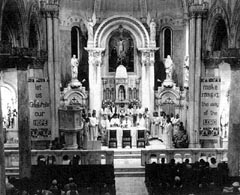23rd Avenue to 40th Avenue & Blake Street, Downing to York
| The Cole-Whittier neighborhoods were in turmoil in the post-World War II era. The Civil Rights movement, Great Society and Model Cities programs, however, had a marked influence on Cole-Whittier. Money was poured into the area during the 1970s, providing a new Recreation Center and the Ford-Warren Library. Urban Renewal Funds helped plant trees and add Morrison Park along Martin Luther King Boulevard (formerly 32nd Avenue) Many streets south of Martin Luther King Boulevard were turned into cul-de-sacs and neighborhood parks and playgrounds. The area further benefitted by the rediscovery of its many fine old houses – a theme that marked older Dnever neighborhoods in the 1970s.
By the 1980s, Cole-Whittier had become a neighborhood of contrasts. It is an area for those looking for real estate values who treasure being in the midst of a dynamic, ever – evolving hub of the city. |
Architecture
| The Cole-Whitter neighborhoods embody a history of Denver. One of the city’s oldest sections, it combines a vast array of architectural styles ranging from stately Victorian mansions to modest 1950s housing. It is particularly marked by numerous distinctive school buildings and churches, each having a fascinating story in its own right.Early architecture in the neighborhood reflected the railroad presence. Styles in the area include Victorian, Queen Anne, Bungalows and Row houses. There are a few Victorian mansions that were homes to railroad executives. Buffalo Bill Cody spent his last years at his daughter’s sedate Queen Anne home at 2932 Lafayette Street.
|
| Landmarks | |
 |
ANNUNCIATION CATHOLIC CHURCH 3601 Humboldt StreetRomanesque Revival cornerstone of the Cole neighborhood designed by Frederick W. Paroth in 1907. Wonderfully old-fashioned interior features 20-foot-high Carrara marble altar and stained-glass windows from the Mayer Company in Munich, Germany. |
